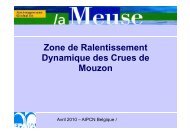PIANC E-Magazine - PIANC AIPCN welcome
PIANC E-Magazine - PIANC AIPCN welcome
PIANC E-Magazine - PIANC AIPCN welcome
Create successful ePaper yourself
Turn your PDF publications into a flip-book with our unique Google optimized e-Paper software.
different values were tested (0.5, 0.55, 0.6, 0.65<br />
and 0.7) to cover the most typical range of values.<br />
For each m and armour unit (double-layer cube<br />
armour, double-layer Cubipod armour and single<br />
layer Cubipod armour), the best fitting probability<br />
density function was obtained (using EasyFit 4.3).<br />
In most cases Gumbell’s distribution accurately<br />
represented the phenomenon (being a distribution<br />
widely used for the extremal characterisation).<br />
The table below (Figure 8) shows the probability<br />
for the different m and elements to be over zero.<br />
• g ƒ<br />
is the overtopping roughness factor, which<br />
depends on the armour unit. Smolka (2008) obtained<br />
these factors in the overtopping formulation.<br />
This factor considers the roughness and<br />
permeability of the structure and depends on<br />
the armour unit among other factors. This variable<br />
is introduced in RU, directly affecting the<br />
wave height of the run-up, common in overtopping<br />
and run-up models: g ƒ<br />
RU.<br />
L 01<br />
• BL is the Ba variable. BL represents the berm<br />
width and time period and it affects the water<br />
flow that arrives at the crown wall through the<br />
armour layer.<br />
€<br />
Figure 8. Probability that S1 is the most unfavourable case<br />
Since in at least 70 % of the cases the estimator<br />
is on the security side, it is reasonable to obtain<br />
the formulae that represent these forces.<br />
3.2. Significant Variables<br />
The main variables that control the horizontal and<br />
up-lift force phenomena are shown in figure 9.<br />
These variables were obtained from the existing<br />
€<br />
formulae.<br />
• RU is the Ru/Rc variable. RU indicates whether<br />
overtopping exists or not and is related to € the<br />
value of the run-up. RU also represents the<br />
higher level of water that reaches the crown<br />
wall.<br />
• RA is the (Rc-Ac)/hf variable. RA represents the<br />
crown wall zone which is not protected by the<br />
berm versus the protected one. This variable<br />
only depends on the cross-section geometry.<br />
• WC is the Wc/hf variable. WC represents the<br />
distance between the foundations of the crown<br />
wall and the mean sea level. This variable depends<br />
only on the cross-section geometry.<br />
The forces were made dimensionless as shown:<br />
• Fh, dimensionless horizontal force:<br />
Fh<br />
ρ ⋅ g⋅ hf 2 ⋅ 0.5<br />
• Fv(Fh), dimensionless up-lift force:<br />
Fv (Fh)<br />
ρ ⋅ g⋅ hf ⋅ Be ⋅ 0.5 , with Be being the base<br />
width of the crown wall.<br />
The forces were calculated considering that the<br />
pressure at each point of the crown wall takes the<br />
value from the nearest pressure sensor. This calculation<br />
does not assume any specific pressure<br />
distribution, since there are as many rectangular<br />
distributions as pressure sensors.<br />
3.3.New Formulae<br />
A linear dependence of some of the variables was<br />
observed, so the initial linear formula for Fh was:<br />
<strong>PIANC</strong> E-<strong>Magazine</strong> n° 144, November/novembre 2011<br />
36




